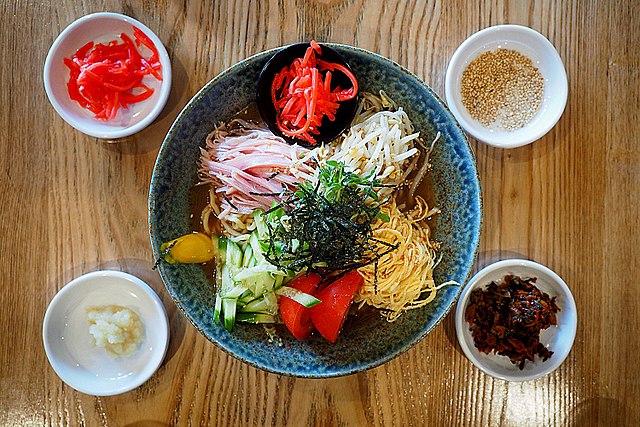Jun 29, 2020
Cold Noodles in Hiroshima
Cold noodles are just what the doctor ordered in the sweltering Japanese Summer! Noodles are an essential staple of Japanese cuisine, eaten by people of all ages in every part of the country. The first bowl of noodles arrived in Japan via Buddhist monks who brought them back from China more than 1000 years ago
Somen Noodles
Somen are thin noodles that are most likely to be enjoyed flowing down a bamboo chute with ice-cold water. It’s often a community a summer event, and everyone lines the bamboo chute clasping a bowl and scoop the noodles from the water as wash along the chute. And you’ll need all of your focus to fish for your lunch if you want to get your fill! Unsurprisingly, this cold noodle dish is usually enjoyed during the summer months and is natural.
Hiyashi Chuka Noodles
Hiyashi chuka Noodles originated in the Sendai area almost a century ago and became an iconic summer dish throughout the archipelago. It is only served in Japanese restaurants during the summertime; signs announcing “Hiyashi chuka served here” let you know that summer has officially begun. It’s light and refreshing and is the perfect summer choice for people who love ramen but want a more refreshing alternative in the sweltering heat.
The name “hiyashi chuka” literally means “chilled Chinese food.” The dish is cold ramen noodles, piled high with colorful toppings in a shallow bowl, and dressed in cold mentsuyu (noodle sauce). Common hiyashi chuka ingredients include cold sliced ham or charshu (Chinese barbecued pork), shredded chicken breast, julienned cucumber, bean sprouts, matchstick carrots, sliced tomato, pickled ginger, and sweet Japanese omelet cut into thin strips.
Hiyashi chuka is sometimes served with a side of yellow karashi (hot Chinese) mustard. The mentsuyu can be any flavor, but popular varieties include soy sauce-based vinaigrette, Japanese citrus dressings like yuzu and ponzu, as well as sesame-based dressings. The dressing is poured over the ingredients just before eating, and then everything is mixed together.
Kunimatsu
Address: 8-10 Hatchobori, Naka Ward, Hiroshima
Hours:
Daily 11 AM–3 PM, 5–9 PM
Closed Sunday
Phone: 082-222-5022
Hiroshima Chuka Soba Baganbo
2-16-1 Kusatsu Shimmachi, Nishi-Ku, Maison Network Saki 1F, Hiroshima
Hours:
Daily
11:30 AM – 2:30 PM
Phone: 082-278-5560
Soba Noodles
I’ve covered soba noodles in an earlier article, but you can’t talk about summer noodles without mentioning the most iconic of noodles in Japan: soba.
Soba noodles are made of buckwheat flour, roughly as thick as spaghetti, and prepared in various hot and cold dishes. Soba dishes are very popular and readily available nationwide. As 100% buckwheat soba noodles tend to be brittle, many restaurants add some wheat flour when preparing their noodles. Depending on the shop, the percentage of buckwheat flour in soba noodles typically ranges between 40% and 100%.
In summer, they are more often than not eaten as zaru soba – a chilled noodle dish made from buckwheat flour and served with soy sauce-based dipping sauce called tsuyu. The word zaru means “a strainer” in Japanese (which is an elegantly simple platter of woven straw), and the name of the dish was derived from the way the noodles are served over a bamboo strainer during the Edo Period.
But my favorite is cold and hard to beat for a light and tasty repast garnished with fresh, crisp tempura. You’ll find most izakaya or Japanese restaurants serve soba but here are a couple of recommendations:
Ita Soba Kaoriya
Address: 2 Chome-7-27 Otemachi, Naka Ward, Hiroshima, 730-0051
Hours:
Daily 11 AM–4 PM, 5–10:30 PM
Phone: 082-247-2490
Iraku-An Soba
Address: 2 Chome-2-22 Ushitanaka, Higashi Ward, Hiroshima, 732-0065
Hours:
Daily 11:30 AM–2 PM, 6–8 PM
Closed Tuesday, Wednesday
Phone: 082-227-6798
Tsukemen Noodles
Tsukemen are usually ramen noodles, though soba or udon are sometimes used instead, and served as a meal that consists of separate servings of noodles and soup or broth; the noodles are dipped in the soup. The noodles are typically served cold, while the soup is typically served hot, which serves to season and moisten the noodles. The noodles can also be served at room temperature. Additional ingredients used in the dish are typically served atop or on the side within the dish of noodles. Some additional ingredients used include nori, chashu, menma, and boiled eggs.
Hiroshima has its own unique take (spicy hot)
Tsukemen Karabu Tokaichimachi
Address: 1 Chome-4-29 Tokaichimachi, Naka Ward, Hiroshima
Hours:
Daily 11:30 AM–3 PM, 6 PM–12 AM
Phone: 082-294-2225
Bakudanya
(A chain store with branches throughout the city, I generally go here:)
Address: 2-12 Shintenchi, Naka Ward, Hiroshima
Hours:
Daily 11:30 AM–12 AM
Phone: 082-546-0089
Image by: insatiablemunch / CC BY


About the author